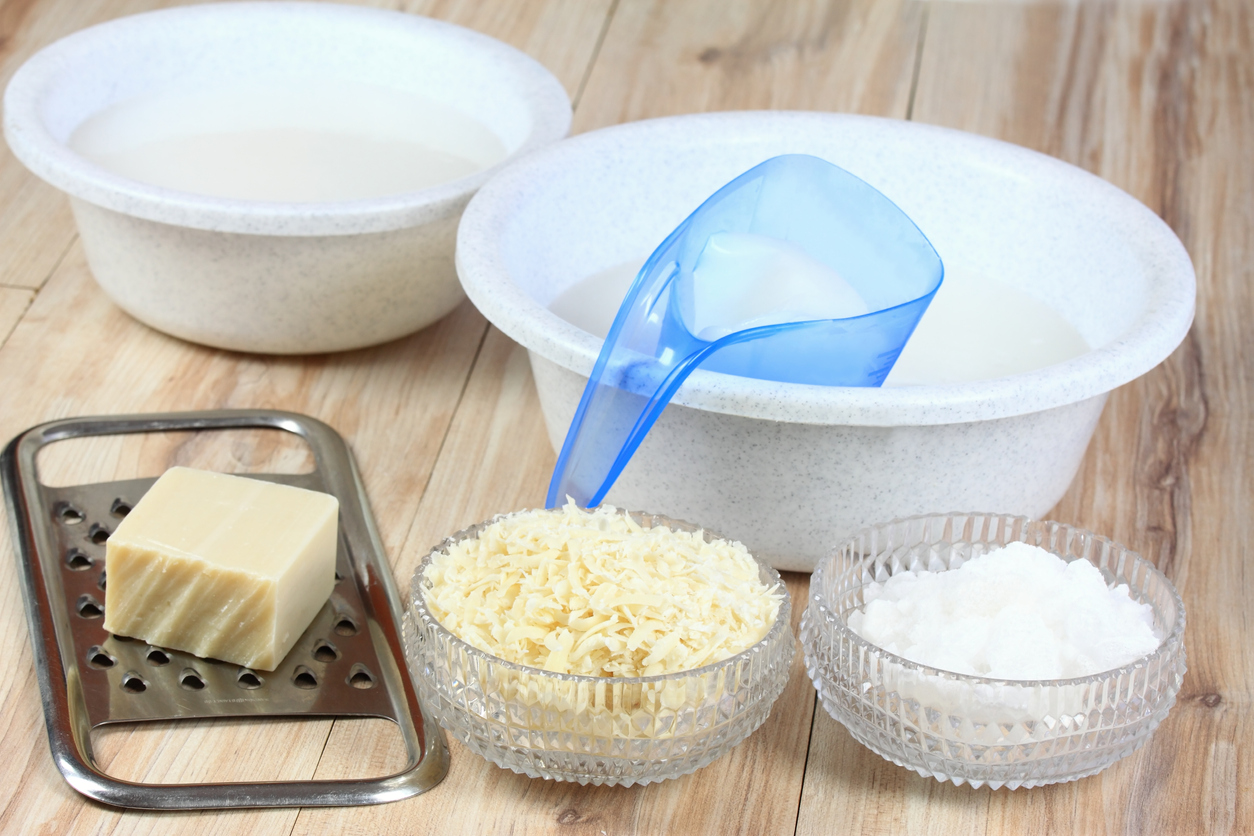We may earn revenue from the products available on this page and participate in affiliate programs. Learn More ›
With just a few commonly available ingredients, you can make homemade laundry detergent. One of the best reasons to consider forgoing commerical products is that when you DIY laundry soap, you can customize it so that it’s just right for you and your family, taking into account fragrance sensitivities, allergies, and environmental impact. Ahead, find homemade laundry detergent recipes for liquid and powdered formulas that are far less expensive than their commercial counterparts.
Project Overview
Working Time: 10 minutes
Total Time: 10 minutes for powdered detergent; 60 minutes for liquid detergent, including cooling time
Skill Level: Beginner
Estimated Cost: $60 (for numerous batches)

Why make your own homemade laundry detergent?
There are clear advantages to DIY-ing a big batch of laundry detergent, but there are also some drawbacks to consider. Here are some pros, cons, and cautions to mull before you take the plunge.
Pro: It’s less expensive.
Making homemade laundry detergent costs significantly less than purchasing it. Five gallons of liquid homemade laundry detergent cost less than $10 to make, whereas 5 gallons of commercial laundry detergent can set you back close to $50.
Con: Making detergent requires effort.
Making laundry detergent is really pretty simple, but given the soap-grating involved, it’s more troublesome and time-consuming than ordering a ontainer of laundry detergent online. Making your own also requires space to store all the ingredients, which might be tricky in homes with limited storage.
Pro: When you DIY detergent, you have control over the ingredients.
When making detergent, you decide what goes in it. You can choose whether to use castile soap or Fels-Naptha, for example, or whether to add a favorite scent or go fragrance-free.
Con: Clothes may feel different or wear faster.
Some people who use homemade detergents find that their clothes feel different than when they are washed with a commercial soap. This is particularly true for those who have hard water. Some folks have even reported quicker degradation of clothing fabric when repeatedly washed in homemade vs. commercial detergents.
Caution: Make sure your DIY detergent is safe to use in your washing machine.
Before buying the necessary supplies, check the manufacturer’s information on the washing machine brand and model to see if they caution against using homemade laundry detergent or any of the ingredients it contains. Using homemade laundry soap might void some brands’ warranties.

How to Make Powdered Laundry Detergent
SUPPLIES
Large airtight container
Castile soap or Fels-Naptha bar soap
Borax
Washing soda
Baking soda
Essential oil for scent (optional)
The following recipe contains common ingredients used to make homemade powdered laundry detergent. For those who prefer liquid detergent to powder, see the recipe below. Before getting started, be sure to have a large airtight container on hand in which to store the detergent. It is recommended to wear a mask while mixing, since the dusty particles can be irritating. Store the finished powder in a cool, dry place for up to a year.
- Using a cheese grater, grate the bar soap (on the side with the smallest openings) and place it in the storage container.
- Add 2 cups of borax to the grated soap.
- Add 2 cups of washing soda.
- Add 2 cups of baking soda.
- Stir everything together.
- If desired, add ½ teaspoon of essential oil and stir again.
Some DIYers add 2 cups of OxiClean for extra cleaning power. Note, however, that this product contains polymers, which can have a negative environmental impact.

How to Make Liquid Laundry Detergent
SUPPLIES
Stock pot (5-quart or larger)
Wooden spoon
Borax
Washing soda
Liquid castile soap (unscented or scented)
Essential oil for scent (optional)
Rather than purchasing a new container for this liquid soap, be frugal and use a rinsed-out commercial laundry detergent container to store your homemade version. Be sure to let the mixture cool thoroughly before putting it into the container. Expect homemade liquid detergent stored in a cool, dry spot to be shelf-stable for about 6 months, though, odds are that it will be used up long before then.
- Bring 6 cups of water to boil in a large saucepan or Dutch oven.
- Add 1 cup of borax and 1 cup of washing soda.
- Stir to dissolve.
- Add 9 cups of room temperature water.
- Add 1 cup of liquid castile soap.
- Stir thoroughly.
- Allow the mixture to cool.
- Pour into a 1-gallon container.
- Add essential oil, if desired, and give the container a good shake.
Instead of using liquid castile soap, you can grate a 5-ounce bar of castile or Fels-Naptha soap as a substitute for the liquid. If the castile soap you use is scented, you’ll probably want to leave out the essential oil.
How much homemade laundry detergent should you put in a wash load?
Because these recipes do not use sudsing agents, they should be safe to use in high-efficiency (HE) machines. We say “should,” but as always, you’ll want to confirm with the manufacturer of your particular machine.
Use 2 to 4 tablespoons of powdered laundry detergent per load for a regular washing machine and 1 to 2 tablespoons for a high-efficiency machine.
For homemade liquid laundry detergent, use ⅛ to ¼ cup for regular washing machines, and for front-loading machines, use 1 to 2 tablespoons of the detergent.
Final Thoughts
Researching how to make your own laundry detergent is a terrific step toward saving money, reducing skin irritation, and minimizing the detrimental impact on the environment caused by some ingredients in commercial detergents. However, we recommend checking your washing machine’s manual (or the manufacturer’s website) to ensure that homemade laundry detergent will not damage the machine. Remember to store this detergent out of reach of pets and children. Although the ingredients are natural, they still may be harmful if swallowed.

